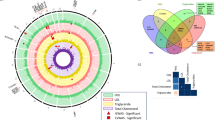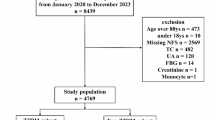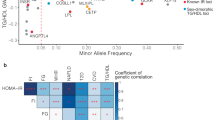Abstract
Although numbers of genome-wide association studies (GWAS) have been performed for serum lipid levels, limited heritability has been explained. Studies showed that combining data from GWAS and expression quantitative trait loci (eQTLs) signals can both enhance the discovery of trait-associated SNPs and gain a better understanding of the mechanism. We performed an annotation-based, multistage genome-wide screening for serum-lipid-level-associated loci in totally 6863 Han Chinese. A serum high-density lipoprotein cholesterol (HDL-C) associated variant rs1880118 (hg19 chr7:g. 6435220G>C) was replicated (Pcombined = 1.4E-10). rs1880118 was associated with DAGLB (diacylglycerol lipase, beta) expression levels in subcutaneous adipose tissue (P = 5.9E-42) and explained 47.7% of the expression variance. After the replication, an active segment covering variants tagged by rs1880118 near 5′ of DAGLB was annotated using histone modification and transcription factor binding signals. The luciferase report assay revealed that the segment containing the minor alleles showed increased transcriptional activity compared with segment contains the major alleles, which was consistent with the eQTL analyses. The expression-trait association tests indicated the association between the DAGLB and serum HDL-C levels using gene-based approaches called “TWAS” (P = 3.0E-8), “SMR” (P = 1.1E-4), and “Sherlock” (P = 1.6E-6). To summarize, we identified a novel HDL-C-associated variant which explained nearly half of the expression variance of DAGLB. Integrated analyses established a genotype-gene-phenotype three-way association and expanded our knowledge of DAGLB in lipid metabolism.
Similar content being viewed by others
Log in or create a free account to read this content
Gain free access to this article, as well as selected content from this journal and more on nature.com
or
References
Castelli W. Cholesterol and lipids in the risk of coronary artery disease–the Framingham Heart Study. Can J Cardiol. 1988;4:5A–10A.
Rahman I, Bennet AM, Pedersen NL, De Faire U, Svensson P, Magnusson PK. Genetic dominance influences blood biomarker levels in a sample of 12,000 Swedish elderly twins. Twin Res Human Genet. 2009;12:286–94.
Willer CJ, Schmidt EM, Sengupta S, et al. Discovery and refinement of loci associated with lipid levels. Nat Genet. 2013;45:1274–83.
Lu W, Cheng YC, Chen K, et al. Evidence for several independent genetic variants affecting lipoprotein (a) cholesterol levels. Hum Mol Genet. 2015;24:2390–2400.
Albert FW, Kruglyak L. The role of regulatory variation in complex traits and disease. Nat Rev Genet. 2015;16:197–212.
Edwards S, Beesley J, French J, Dunning A. Beyond GWASs: illuminating the dark road from association to function. Am J Hum Genet. 2013;93:779–97.
Manolio TA, Fowler DM, Starita LM, et al. Bedside back to bench: building bridges between basic and clinical genomic research. Cell. 2017;169:6–12.
Zhang X, Bailey SD, Lupien M. Laying a solid foundation for Manhattan–setting the functional basis for the post-GWAS era. Trends Genet. 2014;30:140–9.
Li YI, Van dGB, Raj A, et al. RNA splicing is a primary link between genetic variation and disease. Science. 2016;352:600–4.
Feng Z, Lupski JR. Non-coding genetic variants in human disease. Hum Mol Genet. 2015;24:R102–10.
Nicolae DL, Gamazon E, Zhang W, Duan S, Dolan ME, Cox NJ. Trait-associated SNPs are more likely to be eQTLs: annotation to enhance discovery from GWAS. PLoS Genet. 2010;6:e1000888.
Gamazon ER, Zhang W, Konkashbaev A, et al. SCAN: SNP and copy number annotation. Bioinformatics. 2010;26:259–62.
Grundberg E, Small KS, Hedman ÅK, et al. Mapping cis-and trans-regulatory effects across multiple tissues in twins. Nat Genet. 2012;44:1084–9.
Innocenti F, Cooper GM, Stanaway IB, et al. Identification, replication, and functional fine-mapping of expression quantitative trait loci in primary human liver tissue. PLoS Genet. 2011;7:165–71.
Schadt EE, Molony C, Chudin E, et al. Mapping the genetic architecture of gene expression in human liver. PLoS Biol. 2008;6:1020–32.
Liang L, Morar N, Dixon AL, et al. A cross-platform analysis of 14,177 expression quantitative trait loci derived from lymphoblastoid cell lines. Genome Res. 2013;23:716–26.
Xia K, Shabalin AA, Huang S, et al. seeQTL: a searchable database for human eQTLs. Bioinformatics. 2012;28:451–2.
Lonsdale J, Thomas J, Salvatore M, et al. The Genotype-Tissue Expression (GTEx) project. Nat Genet. 2013;45:580–5.
Consortium G. Human genomics. The Genotype-Tissue Expression (GTEx) pilot analysis: multitissue gene regulation in humans. Science. 2015;348:648–60.
Gaulton KJ, Ferreira T, Lee Y, et al. Genetic fine mapping and genomic annotation defines causal mechanisms at type 2 diabetes susceptibility loci. Nat Genet. 2015;47:1415–25.
Peters JE, Lyons PA, Lee JC, et al. Insight into genotype-phenotype associations through eQTL mapping in multiple cell types in health and immune-mediated disease. PLoS Genet. 2016;12:e1005908.
Li M, Luo XJ, Landén M, et al. Impact of a cis-associated gene expression SNP on chromosome 20q11.22 on bipolar disorder susceptibility, hippocampal structure and cognitive performance. Br J Psychiatry. 2015;208:128–37.
Giambartolomei C, Vukcevic D, Schadt EE, et al. Bayesian test for colocalisation between pairs of genetic association studies using summary statistics. PLoS Genet. 2014;10:568–71.
Yao L, Tak YG, Berman BP, Farnham PJ. Functional annotation of colon cancer risk SNPs. Nat Commun. 2014;5:5114–5114.
Birney E, Stamatoyannopoulos JA, Dutta A, et al. Identification and analysis of functional elements in 1% of the human genome by the ENCODE pilot project. Nature. 2007;447:799–816.
Degner JF, Pai AA, Piqueregi R, et al. DNaseI sensitivity QTLs are a major determinant of human expression variation. Nature. 2012;482:390–4.
Grubert F, Zaugg J, Kasowski M, et al. Genetic control of chromatin states in humans involves local and distal chromosomal interactions. Cell. 2015;162:1051–65.
Spain SL, Barrett JC. Strategies for fine-mapping complex traits. Hum Mol Genet. 2015;24:R111–R119.
Kundaje A, Meuleman W, Ernst J, et al. Integrative analysis of 111 reference human epigenomes. Nature. 2015;518:317–30.
Zhu Y, Zhang D, Zhou D, et al. Susceptibility loci for metabolic syndrome and metabolic components identified in Han Chinese: a multi‐stage genome‐wide association study. J Cell Mol Med. 2017;21:1106–16.
Liu Y, Cao L, Li Z, et al. A genome-wide association study identifies a locus on TERT for mean telomere length in Han Chinese. PLoS ONE. 2014;9:e85043.
Price AL, Patterson NJ, Plenge RM, Weinblatt ME, Shadick NA, Reich D. Principal components analysis corrects for stratification in genome-wide association studies. Nat Genet. 2006;38:904–9.
Howie BN, Donnelly P, Marchini J. A flexible and accurate genotype imputation method for the next generation of genome-wide association studies. PLoS Genet. 2009;5:e1000529.
Westra HJ, Peters MJ, Esko T, et al. Systematic identification of trans eQTLs as putative drivers of known disease associations. Nat Genet. 2013;45:1238–43.
Purcell S, Neale B, Todd-Brown K, et al. PLINK: a tool set for whole-genome association and population-based linkage analyses. Am J Human Genet. 2007;81:559–75.
Gusev A, Ko A, Shi H, et al. Integrative approaches for large-scale transcriptome-wide association studies. Nat Genet. 2016;48:245–52.
Zhu Z, Zhang F, Hu H, et al. Integration of summary data from GWAS and eQTL studies predicts complex trait gene targets. Nat Genet. 2016;48:481–7.
He X, Fuller C, Song Y, et al. Sherlock: detecting gene-disease associations by matching patterns of expression QTL and GWAS. Am J Hum Genet. 2013;92:667–80.
Davey Smith G, Ebrahim S. ‘Mendelian randomization’: can genetic epidemiology contribute to understanding environmental determinants of disease? Int J Epidemiol. 2003;32:1–22.
Smith GD, Ebrahim S. Mendelian randomization: prospects, potentials, and limitations. Int J Epidemiol. 2004;33:30–42.
Gamazon ER, Wheeler HE, Shah KP, et al. A gene-based association method for mapping traits using reference transcriptome data. Nat Genet. 2015;47:1091–8.
Wattanamongkhol N, Kumhom P, Chamnongthai K. Cloning of the first sn1-DAG lipases points to the spatial and temporal regulation of endocannabinoid signaling in the brain. J Cell Biol. 2003;163:463–8.
T J, J W-M, K M, A S. Diacylglycerol lipaseα (DAGLα) and DAGLβ cooperatively regulate the production of 2-arachidonoyl glycerol in autaptic hippocampal neurons. Mol Pharmacol. 2013;84:296–302.
Marco EM, Echeverryalzate V, Lópezmoreno JA, Giné E, Peñasco S, Viveros MP. Consequences of early life stress on the expression of endocannabinoid-related genes in the rat brain. Behav Pharmacol. 2014;25:547–56.
Basit S, Ali G, Wasif N, Ansar M, Ahmad W. Genetic mapping of a novel hypotrichosis locus to chromosome 7p21.3–p22.3 in a Pakistani family and screening of the candidate genes. Hum Genet. 2010;128:213–20.
Hsu KL, Tsuboi K, Adibekian A, Pugh H, Masuda K, Cravatt BF. DAGLβ inhibition perturbs a lipid network involved in macrophage inflammatory responses. Nat Chem Biol. 2012;8:999–1007.
Acknowledgements
This work was supported by the National Key Technology R & D Program of China (2009BAI80B02, 2012BAI02B03), the 973 Program (2015CB559100), the National Natural Science Foundation of China (81172755, 31325014, 81421061, 81701321), the 111 Project (B13026), the Program for Zhejiang Leading Team of Science and Technology Innovation (2010R50050), Zhejiang Provincial Program for the Cultivation of High-level Innovative Health Talents, the Program of Shanghai Academic Research Leader (15XD1502200), the National Program for Support of Top-Notch Young Professionals. We would like to acknowledge all the staff and participants in this study for their important contribution.
Author information
Authors and Affiliations
Corresponding authors
Ethics declarations
Conflict of interest
The authors declare that they have no conflict of interest.
Electronic supplementary material
Rights and permissions
About this article
Cite this article
Zhou, D., Zhang, D., Sun, X. et al. A novel variant associated with HDL-C levels by modifying DAGLB expression levels: An annotation-based genome-wide association study. Eur J Hum Genet 26, 838–847 (2018). https://doi.org/10.1038/s41431-018-0108-4
Received:
Revised:
Accepted:
Published:
Issue date:
DOI: https://doi.org/10.1038/s41431-018-0108-4
This article is cited by
-
Genome-wide association meta-analysis yields 20 loci associated with gallstone disease
Nature Communications (2018)



